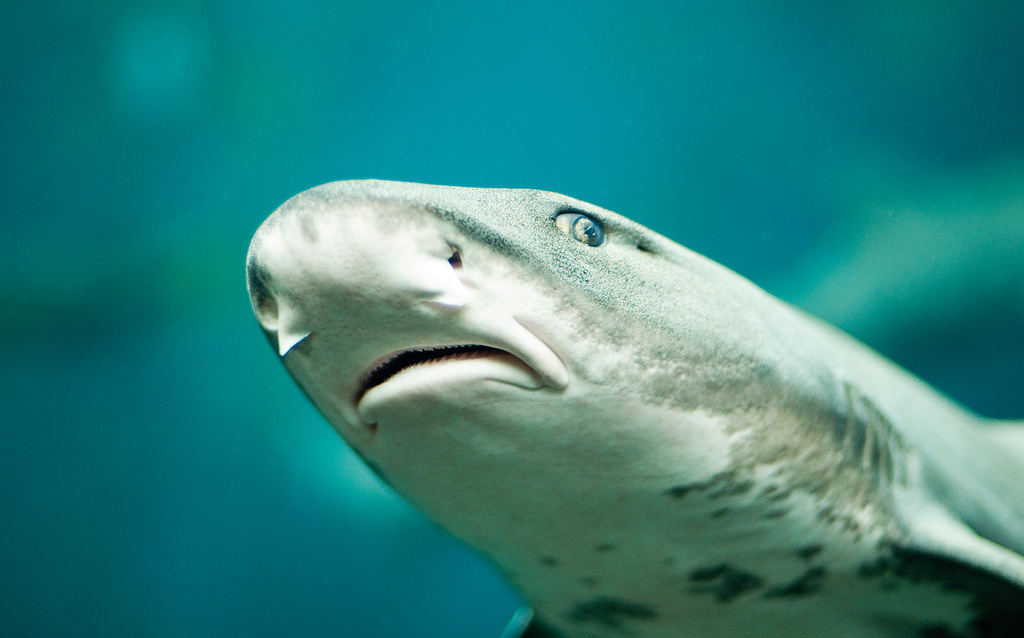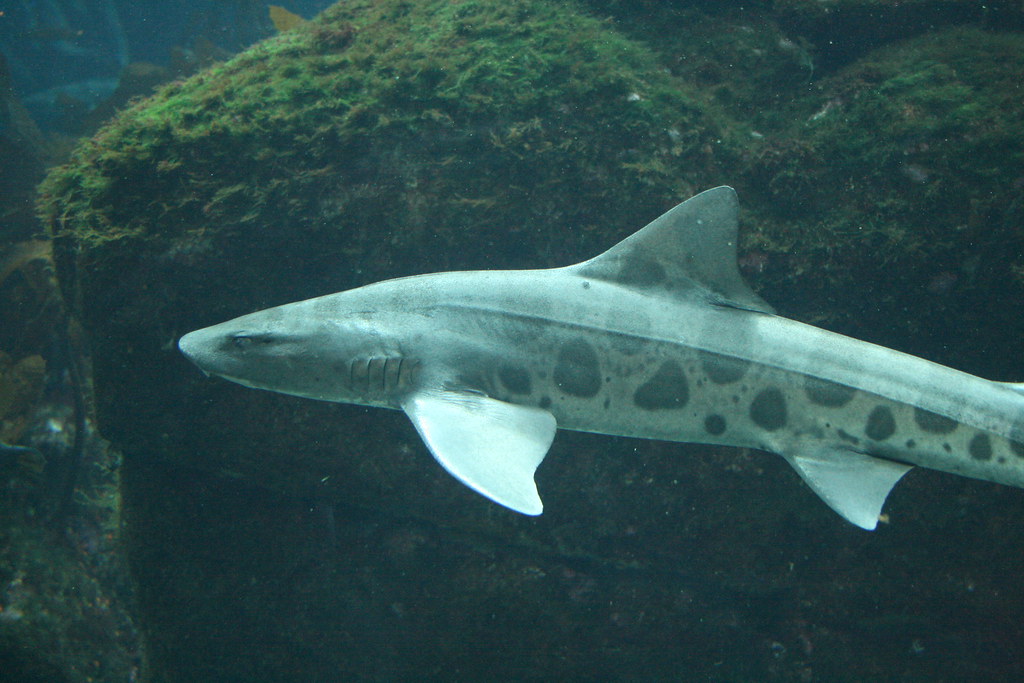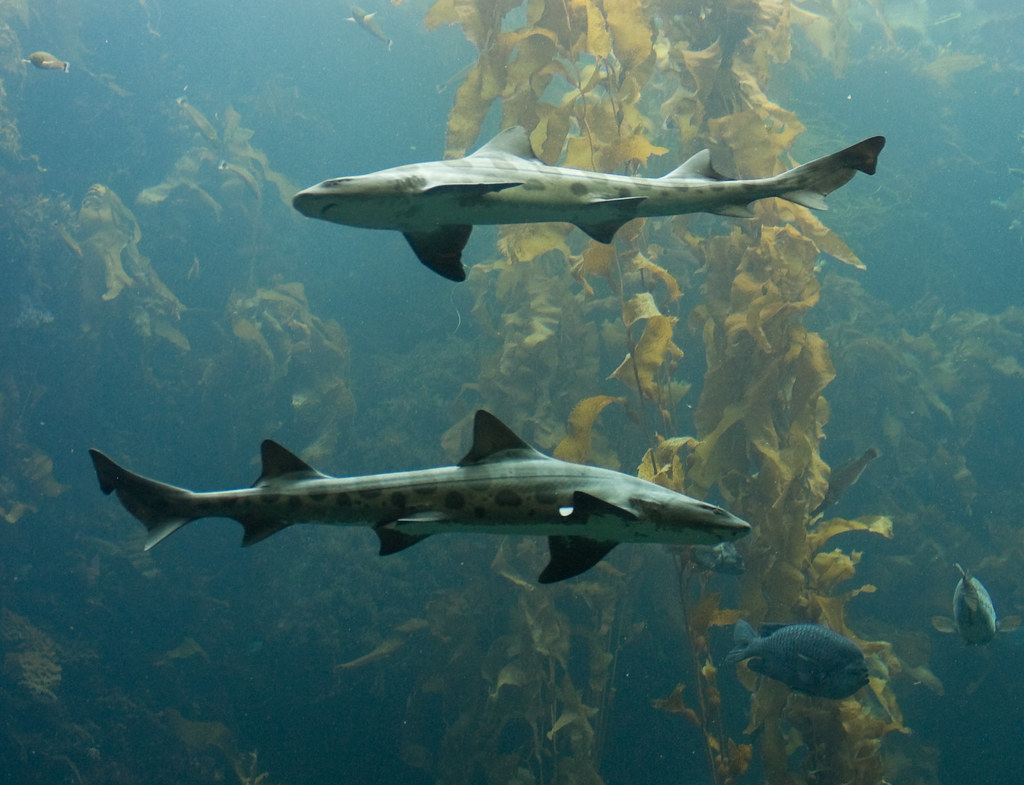.

Leopard Sharks are beautiful, undulating shallow water swimmers with lovely variegated-colour dorsal pattern markings, common and familiar along the California coast. They are eight inches long at birth and rarely grow to more than four feet in length at maturity. If they are able to escape fishermen, they can live to thirty, even forty years. Despite their dangerous-sounding name, they present no threat to humans. (There is a single record from 1955 of a leopard shark harassing a skin diver, causing him to develop a nosebleed.) Leopard sharks mate in summer. Females give birth the following spring. On the northern California coast, bays, sloughs and lagoons offer protected breeding areas. Females drop their pups in beds of eelgrass. The eelgrass provides both shelter and food. For some time the slowly-growing pups continue to forage in tidal flats and shallow coastal waters, possessing the uncanny ability to move out of enclosed areas just in advance of the retreat of the tide.
We lived for many years on a point above Duxbury Reef, a rock protrusion jutting out into the ocean from the Bolinas mesa. On summer's days we made small family expeditions onto the broad shallow tidal flats. Often there were young Leopard Sharks gliding in and out of the small pools created by the rocks. We waded among them without any sign on their part of recognising, much less minding, our presence.
Which was all a very long time ago; but in the way of pleasant memories, that one had remained fixed, "as if sempiternal..."
Until yesterday, that is, when my bravely seagoing partner of these several voyages hove dripping into view, ducking in from the latest wild pre-dawn rainsquall with the daily newspaper.
On the front page, under the top (so this is news?) stories -- latest breaking developments in sexual misconduct among the powerful and great of the anthropoid group, eighty percent of baby products contain or may contain toxic additives -- was this arresting headline: Excessive rainfall is possible killer of leopard sharks.
The story told of a Leopard Shark die-off -- when state officials "decline to use the term 'die-off'" you've got to worry that something's up -- caused by... too much rain.
From Kelly Zito's report:
This winter's heavy rains -- beneficial to so many species -- may, in fact, be diluting saltwater in San Francisco Bay so dramatically that leopard sharks are dying in the very spots where they prefer to give birth and search for food, scientists said Tuesday.
State biologists investigating a rash of leopard shark casualties around the region over the past month think the torrents of freshwater flowing into shoreline lagoons may be throwing the body chemistry of the fish fatally off balance.
"They might be going into these coves to pup," said Carrie Wilson, a marine biologist in Monterey with the California Department of Fish and Game. "If there's more freshwater intrusion and low salinity, it's very tough on these animals."
...hundreds of leopard sharks and rays also died in 2006, the last year rainfall was this far above normal.
More than 100 adult and juvenile leopard sharks have been found dead since mid-April... several scientists and members of the public have reported seeing the animals gasping and thrashing before death, suggesting the sharks could have injured themselves after falling ill.
The first wave of sharks washed ashore near a residential neighborhood in Redwood City. Since then, dozens of the strikingly patterned bottom-feeders have been spotted along the shores of Foster City, San Francisco and Marin County, according to Sean Van Sommeran of the Pelagic Shark Research Foundation.
Longtime East Bay resident Corky Schweizer observed a shriveled adult leopard shark carcass just south of San Francisco Airport on Saturday morning. He said the animal's remains caught his attention because they were so far above the waterline.
"It basically looked like it had launched itself out of the water," Schweizer said...
Though they don't venture out into the deep sea, [leopard sharks] do favor water with salinity levels at the higher end of the spectrum, said Wes Dowd, a postdoctoral scholar at Stanford University's Hopkins Marine Station in Pacific Grove.
Dowd studied the effect of low-salinity water on leopard sharks as part of his thesis. In his experiments, Dowd found that when salinity fell to 19 parts per thousand, the sharks thrust their noses and fins out of the water in an attempt to survive.
Earlier this spring, sensors in some parts of San Francisco Bay recorded salinity levels below 15 parts per thousand, Dowd said. Seawater salinity maxes out at about 34 or 35 parts per thousand.
"When (salinity) moves lower ... it becomes harder for the sharks to compensate for that change in their environment," Dowd said. "They don't cope well."
Though Wilson acknowledges the possible link between the deaths and the rapid influx of freshwater, she declined to use the term "die-off"...
Whatever the roots of the problem, shark specialist Van Sommeran suspects that he and his team of volunteers are collecting only a fraction of the ailing animals.
"We found 50 (sharks) in one canal in Redwood City alone," he said. "Now we're getting calls from Millbrae, San Francisco, Mill Valley, Sausalito -- it seems that the affected area is expanding."
San Francisco Chronicle, 18 May 2011

Leopard Shark (Triakis semifasciata) swimming in a kelp forest, Scripps Aquarium, La Jolla: photo by npzo, 23 August 2008 f

Leopard Sharks (Triakis semifasciata) cross paths in the kelp forest tank, Monterey Bay Aquarium: photo by npzo, 23 August 2008


Young Leopard Shark (Triakis semifasciata) foraging in shallow coastal tide flat near San Diego: photo by Sung Sook, 10 November 2007
